The inverter is a general term used to describe a device that converts DC to DC/AC usually with an associated voltage change. In mains power application an inverter usually takes between 12-48Vdc and converts it to 120-240Vac 50-60Hz. Mains inverters can produce different types of output wave form depending on their internal functionality, and the quantity of cash you want to spend. I.e. square wave, modified sine wave, sine wave.
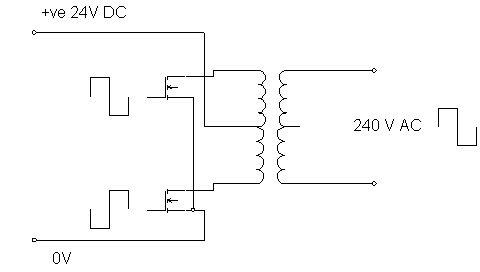
The modified sine wave inverter has an output that follows a sine wave in a stepped manner. The more steps the better the output but there are usually only two or three steps. The peak and rms voltages should be correct i.e. 340Vpk for 240Vrms. The main problem with these is the interference they cause with TV and HiFi equipment. This is more often caused by the fact that the large voltage steps in the wave form radiate R.F. interference from you wiring. You can get lines on your TV screen, a buzz in your telephone (only slight but enough to really piss of a modem) and some PSUs start to smell hot and smoke. Having said that they will do most jobs, they will run any resistive, most low energy and fluorescent lights, deepfreezes and fridges assuming the power rating is ok. Mine is a little skittish about LARGE or multiple SMPS as it does not like the inrush current from the charging the reservoir capacitors.
The sine wave inverters have a sine wave output indistinguishable from mains. The type of sine wave inverter I would like to describe produces a sine wave output using Switch Mode Power Supply techniques. This type of inverter appears a bit complicated to start with but if you look closely you will see it functions in stages and each stage is quite simple.
Stage one is to raise the input DC voltage to a voltage higher than the peak
voltage of the required output sine wave. For a 240Volt 50Hz Mains system the
peak voltage of the sine wave is :-
- 1.414 x 240V = 340.0Volts.
The simplest way to do this is to use a simple push pull chopper circuit similar to the square wave inverter mentioned earlier, but usually running at several kHz.
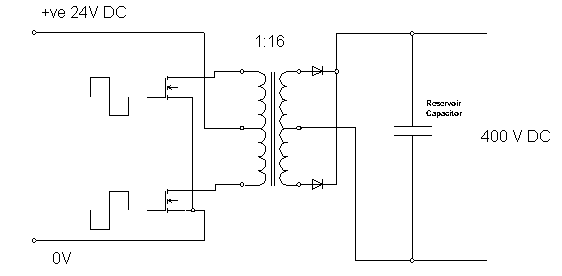
The circuit above gives an unregulated output dependant on the transformer turns ratio and the state of the battery. I.e. if the transformer turns ratio is 1:16 and the supply battery nominally 24V would give
- 24 x 16 = 384Volts.
If it were fully charged lead acid it's terminal voltage would be 13.8V giving an output voltage of
- 28.0 x 16 = 448.0 Volts.
But if were a near fully discharged lead acid battery the terminal voltage will be 10.5V giving
- 21 x 16 = 336.0 Volts.
A very a significant change in output voltage.
A better approach would be to regulate the output voltage. This can be achieved by the addition of an inductor and using a switch mode regulator to control the push pull chopper conduction period.
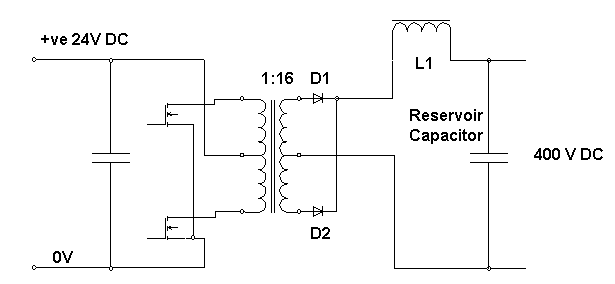
The next thing to do after getting your 400V DC is to convert it to a nice 240Vrms sine wave. This can be done efficiently by using switch mode techniques. The circuit below shows an H Bridge. If Transistors A and D are turned on, with B + C off. The voltage across the load is +ve 400V DC. If Transistors B and C are turned on, with A+D off. The voltage across the load is -ve 400V DC. If these pairs of transistors are switched on and off alternately the O/P would be a 400V AC pk or 800V AC pk-pk SQUAREWAVE.
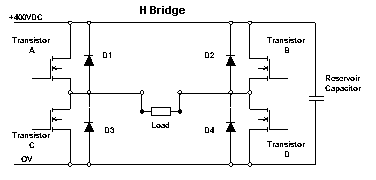
If a filter network is added after the transistors and before the load and pulse width modulation is used to control the transistor conduction period, see the Switch mode Power supplies section. Using transistors A+D an O/P voltage in the range 0 to +ve 400V DC can be achieve, and using the transistors B+C have an O/P voltage in the range 0 to -ve 400V DC can be achieved. You can easily see that by ramping up and then down the o/p voltage in a half sinusoidal manner and then swapping the conducting transistor pairs and repeating the ramping up/down a sine wave o/p can be obtained.
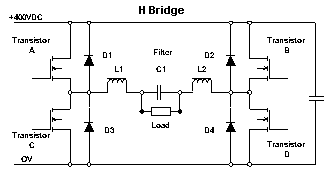
In order to make this work you use a Switch Mode Regulator to control the o/p voltage to make it follow a half sinusoidal reference signal using transistors A and D this produces the positve half cycle and then the same using transistor B and C to produce the negative half cycle.This is the basic principle of most modern Sine wave Inverters